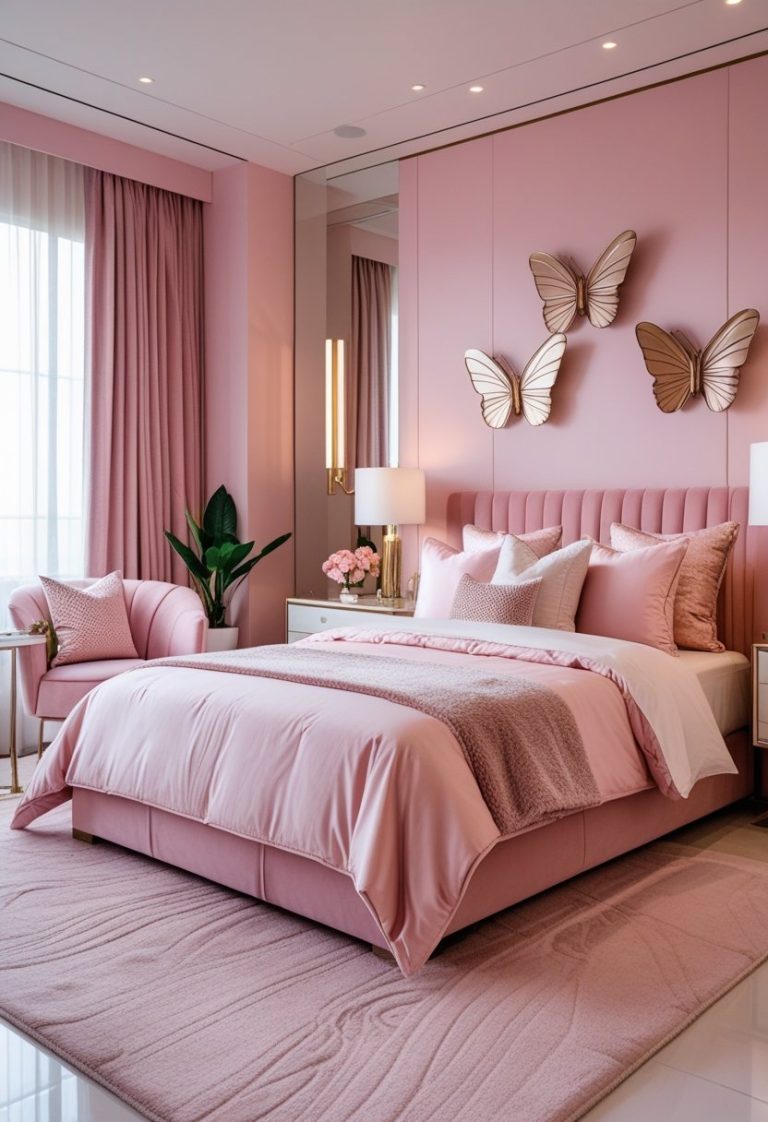Modern Modular Kitchen Design | Sleek & Smart Upgrade
Modern modular kitchen design focuses on maximizing both style and functionality by using smart layouts and contemporary finishes. The L-shaped kitchen layout is a leading choice in 2025 for its ability to optimize space, whether in small or large kitchens. It offers a clean, minimalist look paired with practical features such as sleek cabinets, LED lighting, and intelligent storage solutions.

This design allows homeowners to achieve an elegant and efficient kitchen space that supports a seamless workflow and enhances everyday cooking experiences. By combining modern technology with thoughtful organization, it meets the demands of today’s lifestyle while maintaining a sophisticated appeal.
As kitchen renovation trends evolve, the modular L-shaped layout continues to grow in popularity because it blends aesthetic simplicity with versatile use of space. This approach suits those looking to modernize their home or find innovative ideas that balance luxury and practicality.
Essential Features of Modern Modular Kitchen Design
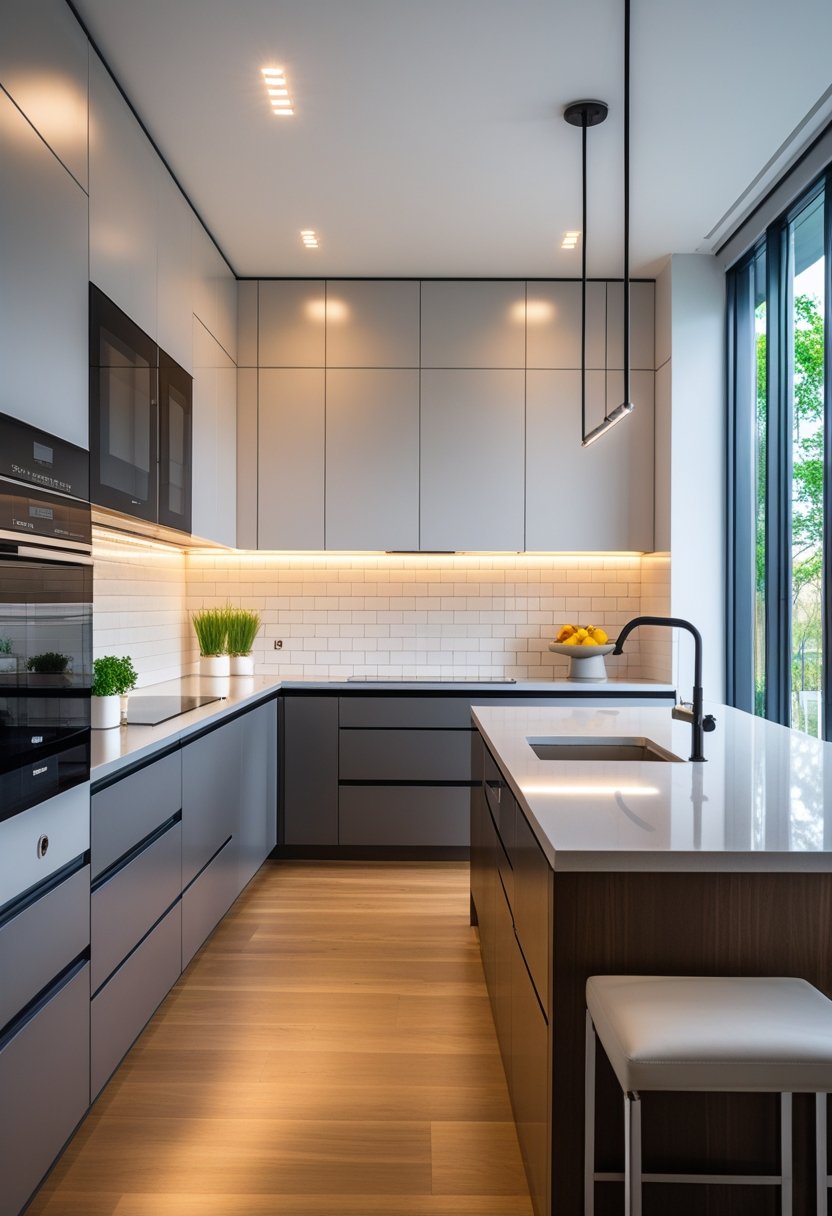
Modern modular kitchen design prioritizes efficient space utilization, durability, and aesthetics. It balances functional storage solutions with sleek, minimalist layouts that accommodate both small and large areas. The integration of smart lighting and ergonomic planning enhances usability and durability.
Defining Modular Kitchens
A modular kitchen consists of pre-manufactured cabinet units or modules that fit together to form the overall kitchen layout. These kitchens allow customization in terms of size, material, and finish. Modules often include base cabinets, wall cabinets, drawers, and shelves designed to optimize every inch of space.
Materials are typically durable and easy to maintain, such as laminated plywood or metal. This design enables quick installation and easy reconfiguration, unlike fixed traditional kitchens. The modular approach supports clean lines, modern aesthetics, and a clutter-free environment.
Benefits of Modular Kitchens
Modular kitchens offer significant advantages, including smart storage solutions that reduce wasted space. Features like pull-out drawers, corner carousels, and handleless cabinets enhance accessibility and convenience. LED lighting integrated inside cabinets improves visibility for cooking and cleaning.
Durability is improved through quality materials resistant to moisture and warping. Modular kitchens are easier to customize and upgrade over time. They also support efficient workflow designs, making cooking safer and more enjoyable by keeping key appliances and storage within reach.
Comparing Modular and Traditional Kitchens
Traditional kitchens are generally built on-site, often custom-made with fixed cabinetry. This can limit flexibility when renovating or adapting the space later. Traditional designs tend to use heavier wood and may require longer installation times.
In contrast, modular kitchens use standardized units, enabling faster installation and easier replacement. Modular designs emphasize a minimalist, contemporary look that is often absent in traditional kitchens. Maintenance is simpler, and updates to design or layout can be accomplished with minimal disruption.
Luxury L-Shaped Modular Kitchen Layout
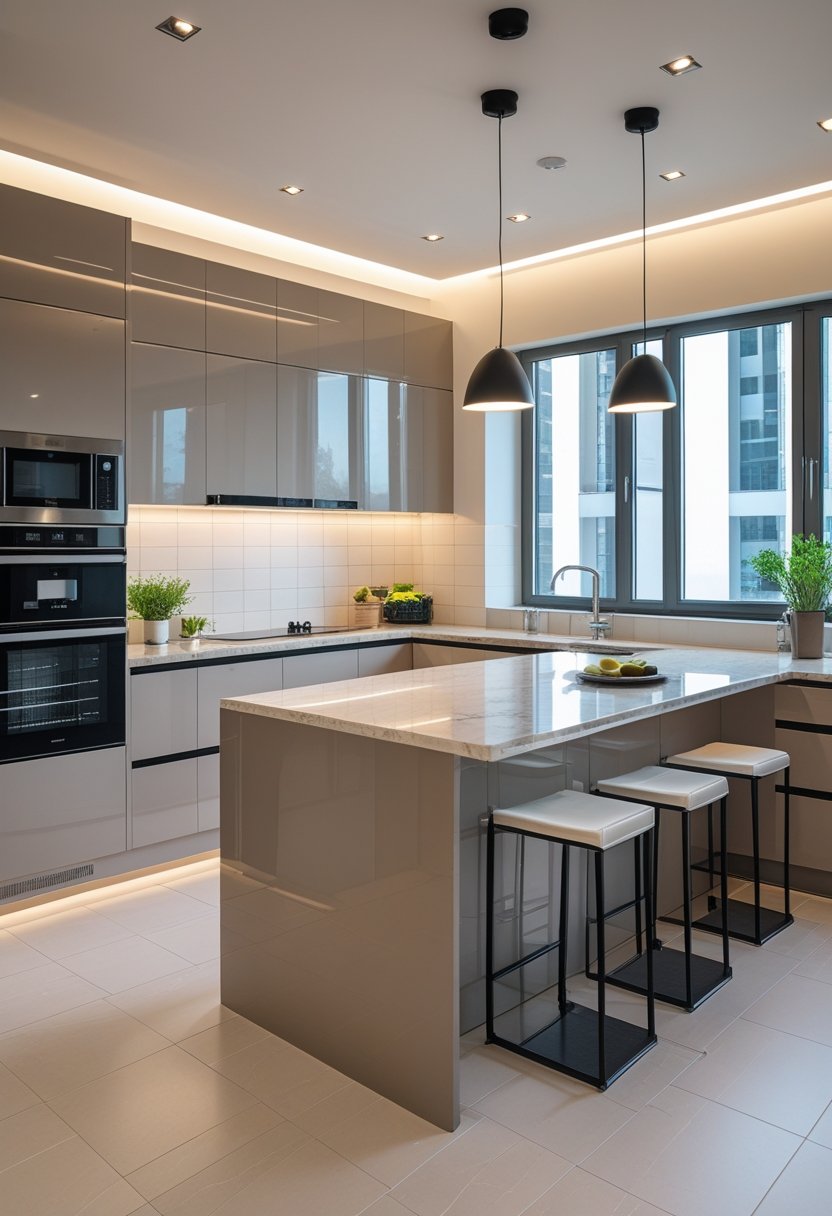
This design uses two perpendicular walls to create a clean, efficient workspace with premium materials and finishes. It incorporates smart storage elements and advanced lighting to combine practicality with an elegant appearance. The layout adapts well to various room sizes and shapes.
L-Shaped Modular Kitchen Overview
The L-shaped modular kitchen consists of cabinetry and appliances placed along two adjoining walls, forming a right angle. This layout promotes a natural workflow by positioning the sink, stove, and refrigerator within easy reach, often referred to as the kitchen work triangle.
Durability is enhanced through the use of high-quality modular components such as engineered wood or metal frames with scratch-resistant finishes. Cabinets and drawers often feature soft-close mechanisms for longevity and convenience.
Modern versions emphasize sleek, minimalist designs with integrated LED lighting that highlights clean lines. This approach balances aesthetic appeal with the robust functionality expected from a modular kitchen system.
Space Planning and Workflow
Efficient space use is critical for this layout. The open corner area created by the L-shape allows for extra countertop space or additional cabinetry. Smart storage, like pull-out shelves and corner carousels, maximizes otherwise unused spaces.
The layout supports an intuitive workflow by reducing movement between key tasks. It helps maintain a clear separation between cooking, prepping, and cleaning zones while keeping all within easy access.
Lighting plays a significant role. Integrated LED strips under cabinets improve visibility while maintaining the kitchen’s sleek, modern look. This contributes to a practical and comfortable work environment.
Suitability for Small and Large Kitchen Spaces
The L-shaped modular kitchen adapts well to various kitchen sizes. In smaller spaces, it avoids overcrowding by using two walls efficiently, leaving open floor space for movement or even a dining area.
For larger kitchens, it allows integration of additional features such as an island or a breakfast bar, providing more prep surfaces and seating without compromising workflow. This flexibility makes it a popular choice for both compact apartments and spacious open-plan homes.
This layout suits different design styles and can be tailored with various cabinet finishes, hardware, and lighting options to meet specific preferences and functional needs.
Sleek Cabinetry Trends and Material Choices
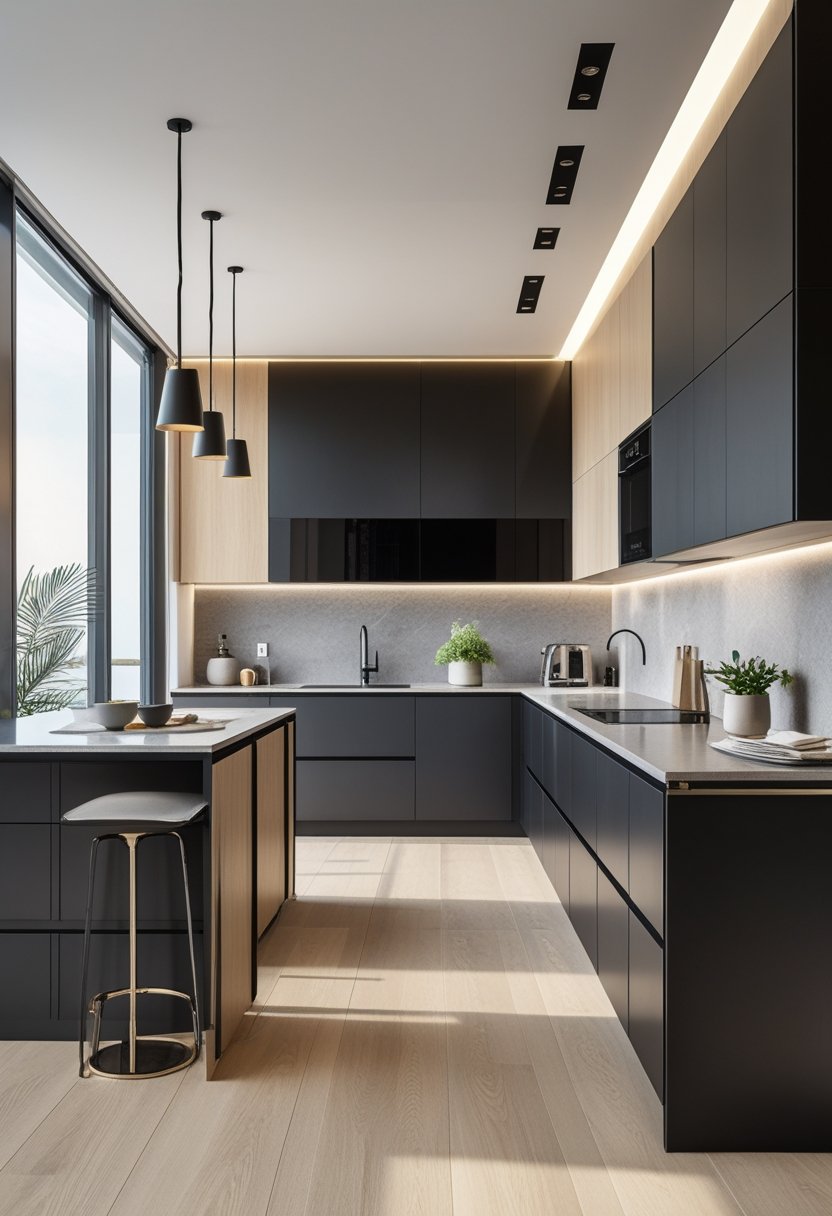
Modern modular kitchen designs emphasize clean lines, functional storage, and materials that balance durability with style. Contemporary cabinetry combines minimalist forms with smart features, enabling homeowners to maximize space without sacrificing aesthetic appeal.
Minimalist Cabinets and Handleless Designs
Minimalist cabinets focus on simplicity and smooth surfaces that contribute to the kitchen’s sleek appearance. Handleless designs, often featuring push-to-open or integrated grip systems, eliminate visual clutter and streamline cabinet fronts.
This design choice enhances the modular kitchen’s clean geometric look, making it easier to maintain. The absence of handles also complements minimalist and monochromatic color schemes, particularly when paired with matte or glossy finishes.
Ergonomics and durability are carefully balanced in these cabinets, ensuring that while they are visually subtle, they remain practical for daily use. This trend is popular in both small and large kitchen layouts due to its space-saving benefits.
Dual-Tone and Glass-Front Cabinetry
Dual-tone cabinetry introduces visual interest by combining contrasting or complementary colors within the same kitchen design. It often pairs darker base cabinets with lighter overhead units, creating depth and breaking monotony.
Glass-front cabinets add an element of transparency, making kitchens feel more open and airy. They are commonly used for overhead cabinets to display tasteful dishware or accent lighting, enhancing the room’s ambiance.
Combining glass panels with sleek frames maintains modern aesthetics without compromising on storage. This style supports personalization, allowing homeowners to choose cabinet finishes that fit both traditional and contemporary settings.
Material Selection for Cabinets
Cabinet materials are vital for durability, style, and maintenance. Popular choices include MDF (Medium Density Fiberboard) with laminate or acrylic finishes, offering smooth, easy-to-clean surfaces.
Wood veneers provide a natural texture and warmth but require proper sealing to resist moisture. Aluminum and tempered glass are used in high-end designs for their sleek appearance and longevity.
Eco-friendly options incorporating sustainable and recycled materials are growing in demand. These materials ensure that kitchens remain resistant to heat, scratches, and humidity while aligning with green building standards.
Floating and Overhead Cabinets
Floating cabinets create a sense of space by visually detaching storage units from the floor, which is especially useful in smaller kitchens. They often feature LED strip lighting underneath, improving task illumination and enhancing design appeal.
Overhead cabinets maximize vertical storage and are typically designed with slim profiles and lightweight materials to maintain the kitchen’s open feel. Their placement is strategic to avoid crowding and to maintain ease of access.
Both floating and overhead cabinets integrate seamlessly with smart storage solutions, including pull-out shelves and modular compartments, to optimize organization without compromising style. They are key elements in modern modular kitchen designs focused on efficiency.
Smart Storage Solutions for Functionality
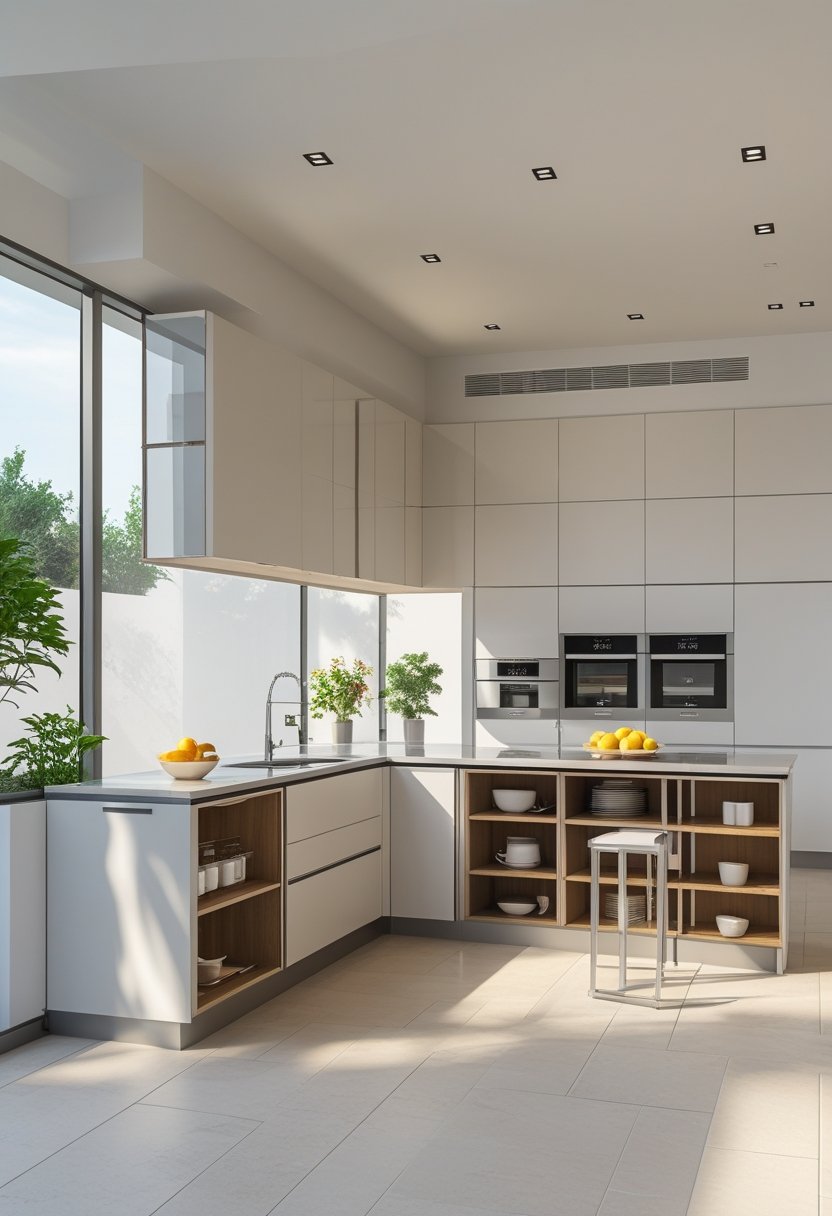
Maximizing storage while maintaining accessibility is critical in modern modular kitchens. Efficient storage systems help keep essentials organized without sacrificing style or space. Key features include specialized units that optimize corners, customizable drawers, and pull-out pantries tailored for easy reach and neatness.
Pull-Out Pantry Units
Pull-out pantry units offer vertical storage that fully utilizes narrow spaces between cabinets or appliances. These units slide out smoothly, allowing access to frequently used items like spices, canned goods, and dry ingredients without bending or stretching.
They often come with adjustable shelves or baskets to accommodate different container sizes. Built into modular kitchen cabinets, pull-out pantries make use of otherwise wasted narrow gaps and help prevent clutter on countertops.
In smaller kitchens, a pull-out pantry can replace bulky freestanding cupboards, saving floor space and adding a sleek, integrated look. Soft-close mechanisms and modular design features increase convenience and durability.
Magic Corners and Corner Storage
Magic corners transform difficult-to-reach cabinet corners into accessible, practical storage zones. These systems use rotating or sliding shelves that extend outward when the cabinet door opens, providing full visibility and easy access to pots, pans, and kitchen tools stored deep inside corners.
This solution overcomes common issues with under-utilized corner spaces in L-shaped or U-shaped kitchens. Magic corners maximize modular kitchen cabinets’ storage capacity, allowing homeowners to organize bulky items efficiently without wasted areas.
Their design reduces the need for heavy lifting and awkward reaching. Magic corners often come with customizable inserts and are compatible with soft-close hinges, enhancing user comfort and kitchen workflow.
Drawer Systems and Organizers
Drawer systems in modular kitchens are designed to optimize space with divided compartments, adjustable heights, and specialized inserts. These systems include utensils trays, plate racks, and deep drawers for larger cookware, all helping separate items for quicker access.
Organizers inside drawers reduce clutter by keeping items neatly arranged and preventing shifting during drawer movement. Modular designs allow customization based on individual storage needs, increasing functional versatility.
Soft-close drawers with full extension rails improve the experience by providing smooth operation and complete access to stored items. These features contribute to the minimalist aesthetic by concealing clutter and supporting orderly kitchens.
Lighting and Visual Enhancements
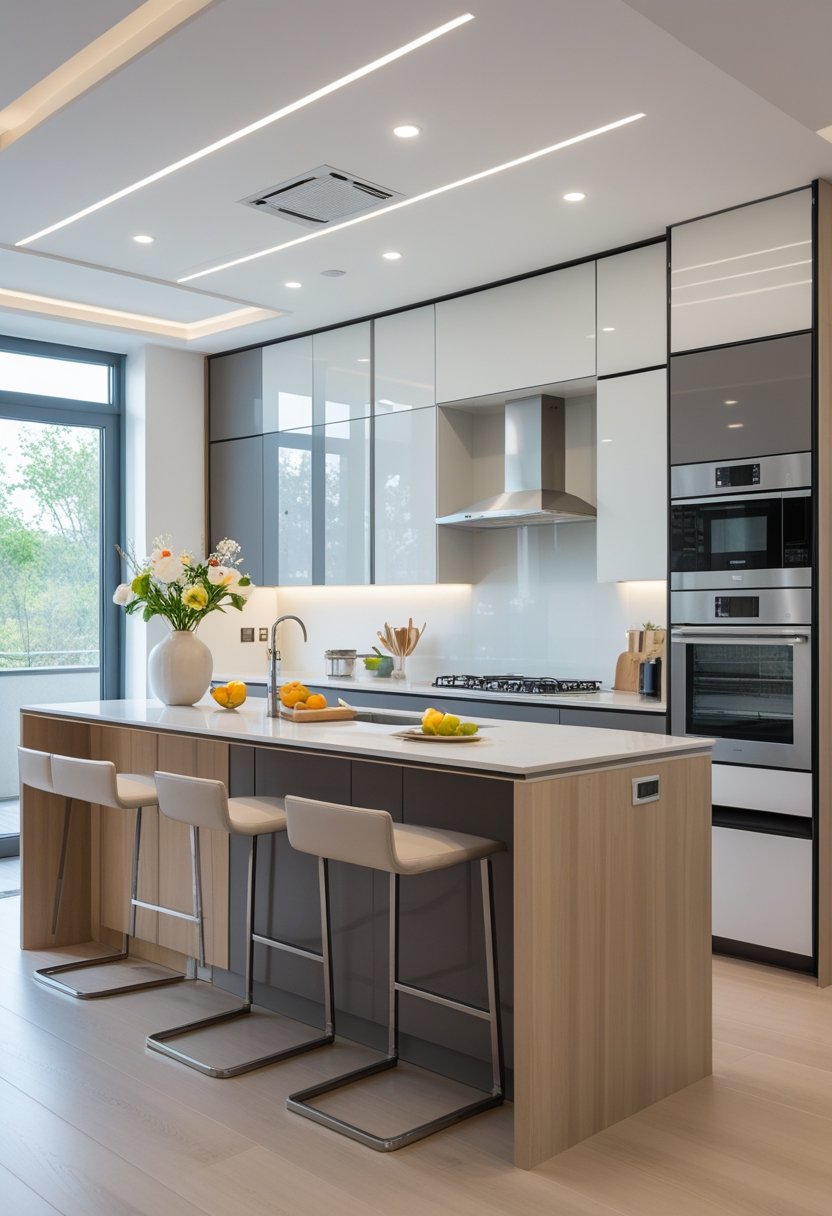
Effective lighting and carefully chosen finishes dramatically improve both functionality and style in modern modular kitchens. Strategic placement of light sources and the incorporation of metallic highlights can create an inviting atmosphere while supporting seamless daily tasks.
LED and Under-Cabinet Lighting
LED lighting is essential for brightening workspaces without adding bulk. It provides consistent illumination and is energy-efficient, lasting longer than traditional bulbs. Under-cabinet LED strips specifically target countertops, reducing shadows when preparing food.
This lighting type can also be dimmable, allowing users to adjust brightness according to need or time of day. Installing LED fixtures beneath cabinets keeps the design minimal and uncluttered while dramatically enhancing visibility in key areas.
This setup supports a clean, streamlined look, amplifying the kitchen’s modern aesthetic. It integrates functionality with subtle design, making it popular in luxury L-shaped kitchen layouts.
Metallic Accents for a Modern Look
Metallic accents like brushed stainless steel, matte brass, or chrome enhance kitchen visuals by adding texture and contrast. These materials are frequently used for cabinet handles, faucets, and backsplashes.
Besides their aesthetic appeal, metallic finishes are durable and easy to maintain. They resist everyday wear and complement minimalist color schemes, often breaking up monotony in white or monochromatic kitchens.
Using metallic details strategically can emphasize clean lines and create a sophisticated, contemporary atmosphere. Paired with LED lighting, these accents reflect light, amplifying the space’s brightness and adding subtle depth to the overall design.
Countertop Materials for Modern Elegance

Choosing the right countertop material is crucial for balancing durability with sophisticated design in modern kitchens. Options vary in maintenance, appearance, and cost, so understanding key trends helps refine selections that emphasize sleekness and practicality.
Quartz Countertops
Quartz stands out as a top choice for modern modular kitchens due to its durability and low maintenance. Engineered from natural quartz and resin, it resists scratching, staining, and heat better than many natural stones.
Quartz’s non-porous surface also inhibits bacterial growth, making it hygienic for food preparation. It comes in a wide range of colors and finishes— from polished to matte—allowing customization that complements minimalist and industrial modern aesthetics.
Its engineered uniformity contributes to clean lines and sleek surfaces, essential in L-shaped kitchens prioritizing seamless flow and easy upkeep. While quartz usually costs more than laminate, it offers longer-lasting value aligned with luxury kitchen standards.
Color Palette and Texture Trends
Modern kitchens increasingly favor neutral shades like whites, greys, and blacks to create a calm, cohesive look. These colors pair well with modular cabinetry featuring flat or handleless fronts.
Textured finishes mimic natural stones like marble or concrete but provide greater consistency and resilience. Matte and honed surfaces reduce glare and fingerprints, enhancing functionality in busy kitchens.
Adding subtle veining or soft patterns in light or dark tones introduces visual interest without disrupting minimalism. Combining these textures with LED lighting further highlights subtle material details, reinforcing a sophisticated atmosphere.

Ana Luisa
Explore in-depth biographies, net worth insights, and exclusive updates on your favorite singers at Trionua.com. Discover the journeys, achievements, and latest news about music’s biggest stars.


